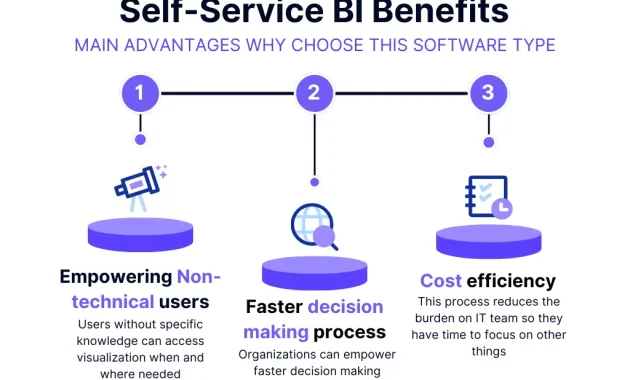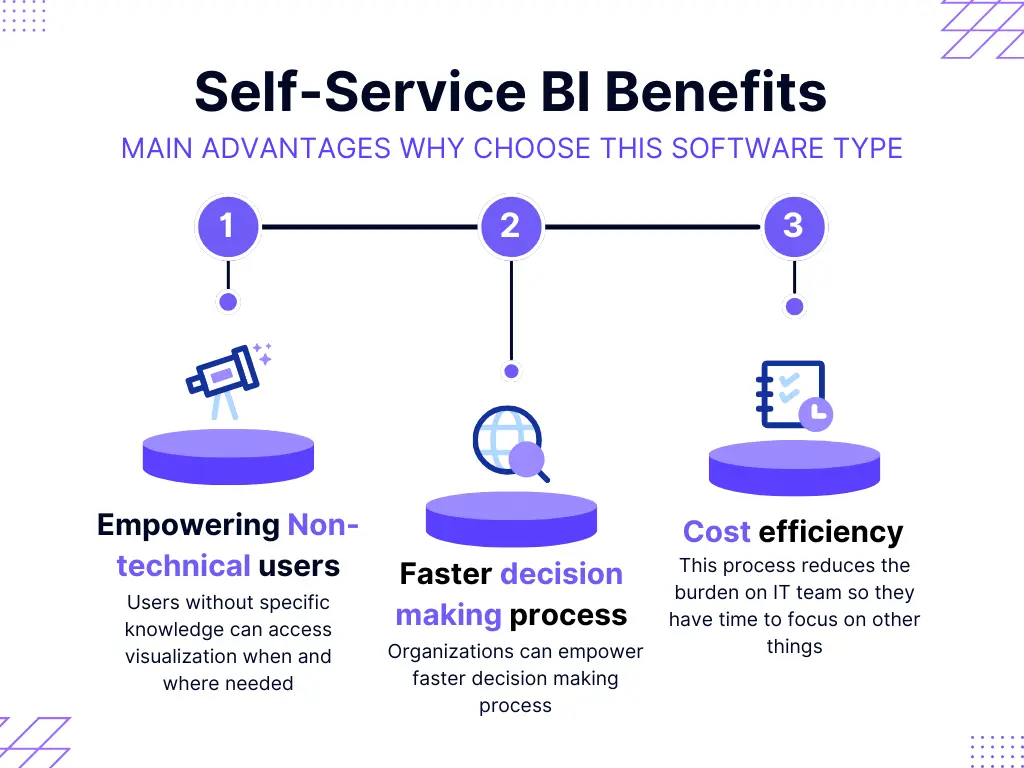
Self-Service Business Intelligence Software: Leading Smarter Decisions in the Modern Era
The modern business landscape is awash in data. Companies of all sizes are collecting vast amounts of information, from customer behavior and market trends to operational efficiency and financial performance. The challenge lies not in the acquisition of data, but in its effective analysis and utilization. This is where self-service business intelligence software steps in, empowering users to lead smarter decisions.
Self-service business intelligence software allows business users, regardless of their technical expertise, to access, explore, analyze, and visualize data. This democratization of data analysis is transforming how organizations operate, fostering a culture of data-driven decision-making. The ability to quickly extract insights from data allows for agile responses to market changes and proactive identification of opportunities. This article delves into the capabilities, benefits, and considerations surrounding the implementation of self-service business intelligence software.
Understanding Self-Service Business Intelligence
At its core, self-service business intelligence (BI) is a methodology and a technology that empowers business users to independently analyze data. It allows them to create their own reports, dashboards, and visualizations without relying on IT or data specialists. This shifts the paradigm from a centralized, IT-driven approach to a more decentralized, user-centric model. The key components of self-service BI include:
- Data Connectivity: The ability to connect to various data sources, including databases, spreadsheets, cloud platforms, and APIs.
- Data Preparation: Tools for cleaning, transforming, and shaping data to make it ready for analysis.
- Data Visualization: A range of visual tools like charts, graphs, and maps to present data insights in an easily understandable format.
- Reporting and Dashboards: Capabilities to create interactive reports and dashboards that track key performance indicators (KPIs).
- Advanced Analytics: Some solutions offer advanced analytics features, such as predictive modeling and machine learning.
Self-service BI tools often feature user-friendly interfaces, drag-and-drop functionality, and pre-built templates. This makes it easier for business users to get started and quickly derive value from their data. This shift in data access empowers employees to make data-driven decisions. This also improves overall business performance.
Benefits of Implementing Self-Service BI
The adoption of self-service business intelligence software offers a multitude of benefits. These advantages contribute to improved efficiency, enhanced decision-making, and a stronger competitive position:
- Faster Decision-Making: Users can access and analyze data in real-time, leading to quicker insights and faster decision cycles.
- Improved Agility: Businesses can respond more quickly to market changes and emerging trends. They can adjust strategies accordingly.
- Increased Efficiency: By empowering users to perform their own analysis, self-service BI reduces the burden on IT departments and data specialists.
- Enhanced Collaboration: Self-service BI tools often facilitate collaboration. Users can share reports, dashboards, and insights with colleagues.
- Reduced Costs: By automating reporting and analysis, self-service BI can reduce the costs associated with traditional BI approaches.
- Improved Data Literacy: The use of self-service BI tools helps to improve data literacy. Employees become more familiar with data analysis.
- Better Business Outcomes: Data-driven decisions lead to better outcomes. This encompasses improved sales, increased profitability, and enhanced customer satisfaction.
These benefits collectively contribute to a more data-driven culture. This allows organizations to become more competitive and successful.
Choosing the Right Self-Service BI Software
Selecting the appropriate self-service business intelligence software is crucial for success. Several factors should be considered during the evaluation process:
- Ease of Use: The software should have an intuitive interface. It should be easy for business users to learn and use.
- Data Connectivity: Ensure the software can connect to all relevant data sources. This includes databases, spreadsheets, and cloud platforms.
- Data Visualization Capabilities: The software should offer a wide range of visualization options. It should also allow for customization of visualizations.
- Reporting and Dashboarding: The software should allow users to create interactive reports and dashboards. These should track key performance indicators.
- Scalability: The software should be able to handle growing data volumes. It should also accommodate an increasing number of users.
- Security: The software should offer robust security features. This safeguards sensitive data.
- Pricing: Consider the pricing model and ensure it aligns with your budget and needs.
- Support and Training: Evaluate the availability of customer support. Also, assess the quality of training resources.
Popular self-service business intelligence software options include Tableau, Microsoft Power BI, Qlik Sense, and Domo. Each of these platforms offers a unique set of features and capabilities. They cater to different business needs and organizational sizes. Thorough research and evaluation are essential. This ensures the selection of the best software for your specific requirements.
Implementing Self-Service BI: Best Practices
Successful implementation of self-service business intelligence software requires a well-defined strategy and adherence to best practices:
- Define Clear Objectives: Clearly articulate the business goals you want to achieve with self-service BI.
- Identify Key Users: Determine the users who will be using the software and their specific needs.
- Plan Data Governance: Establish data governance policies to ensure data quality, security, and compliance.
- Provide Training and Support: Offer comprehensive training and ongoing support to users. This ensures effective adoption.
- Start Small and Iterate: Begin with a pilot project. Expand the implementation gradually.
- Foster a Data-Driven Culture: Encourage data-driven decision-making across the organization.
- Monitor and Evaluate: Regularly monitor the use of the software. Evaluate its impact on business outcomes.
By following these best practices, organizations can maximize the benefits of self-service BI. They can also drive a successful implementation.
The Future of Self-Service BI
The self-service business intelligence software landscape is continuously evolving. Several trends are shaping the future of this technology:
- Artificial Intelligence (AI) and Machine Learning (ML): AI and ML are being integrated into self-service BI platforms. These tools automate data analysis. They also provide predictive insights.
- Natural Language Processing (NLP): NLP enables users to interact with the software using natural language queries. This simplifies data exploration.
- Cloud-Based BI: Cloud-based self-service BI solutions are gaining popularity. They offer greater scalability and accessibility.
- Mobile BI: Mobile BI allows users to access data and insights on their mobile devices. This provides real-time access to information.
- Data Storytelling: The ability to create compelling data stories is becoming increasingly important. This helps to communicate insights effectively.
These trends are making self-service BI more accessible, powerful, and user-friendly. The future of self-service BI promises even greater capabilities. This will further empower organizations to make smarter decisions.
Conclusion: Leading with Data
Self-service business intelligence software is no longer a luxury. It is a necessity for organizations seeking to thrive in today’s data-driven world. By empowering business users to analyze and visualize data, self-service BI facilitates faster decision-making. It also improves agility and drives better business outcomes. By carefully selecting the right software, implementing best practices, and embracing the latest trends, organizations can unlock the full potential of their data. They can lead smarter decisions and achieve a competitive advantage. The future of business intelligence is undeniably self-service, and those who embrace it will be best positioned to succeed. [See also: Data Visualization Tools for Beginners]
Self-service business intelligence software empowers smarter decisions. Organizations can harness the power of data. They can make informed choices for success.

